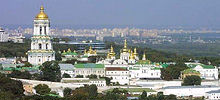Kievtown.net
Kiev travel guide

Kievtown.net Kiev travel guide |
 |
|||
SIGHTS: Kreschatik Monument to Bogdan Khmelnitsky
|
How to get: go to metro stations Kreshatik or Maydan Nezalezhnosti
Kreschatik is Kiev main street that is located near to district, where prince Vladimir the Great baptized his family once. Probably, the street takes its name from this fact, but under other version, the street was named so because of Kreshchatiy Jar (that is crossed over by transversal ravines). Kreshatik is not very long street Ц just 1,2 km, but its average width is 75 m. now, and some sections reach 100 m. width. Traffic area takes 24 m., and there are 14-metres footwalks, separated by trees, on the both sides of the street. Chestnut parkway stretches along the right side of Kreshatik, especially beautiful during the chestnutsТ flowering in spring. Kreshatik began its history as a street in the end of 18 Ц the beginning of 19 centuries. At first a district around European (Horse) square was built up. Building was conducted mainly on the right side till Proresnaya Street. Then the building passed to the left side of the road. At that time Kreshatik was built up basically with residential buildings, except for the first Kiev theatre Ц a manor, constructed under the project of A. Melensky. For this reason the street was shortly called Theatrical. By the end of 1873, the street building reached Bessarabsky square. Till 1869 main street of Kiev had the name Kreshchatitskaya, and was renamed into Kreshatik then. Till Great Patriotic War Kreshatik was a 3-4-floor street, and its width was approximately 35 m.
In 1851, first big stone building for a noble family provincial meeting was built. Architect A. V. Beretti was the author of the project. Under the project of this architect building of Institute of noble girls was constructed in 1838-1942. At that time trading and industrial life of Kiev was concentrated in Podol. As far as Kreshatik was expanded and built up, it gradually became new centre of the city business life. Already by the end of 19 century, Kreshatik was a completely built up street. Here there was a set of shops, banks, various offices. In 1892 first in Russian empire line of electric tram, connecting Kreshatik and Podol, was laid at the street. In the beginning of 20 century House of Russian insurance society was constructed at the corner of Kreshatik and Proresnaya Street under the project of famous architect V. Gorodetskiy. In 1914 Passage, consisting of two parallel cases, connected by collars that formed a passage, was constructed under P. S. Andreev's project. Passage building was destroyed during Second World War, and during post-war years it was reconstructed. Approximately during the same time buildings of Bessarabsky covered market and Merchant meeting (National philharmonic society of Ukraine), the present places of interest of Kiev, were built.
Already in the beginning of 20 century the houses of Kreshatik had a waterpipe, sewer system, gas and electricity. During Soviet period Kreshatik was reconstructed and equipped more actively in 1936-1941. Tram rails were removed, traffic area was asphalted, and more modern type of transport Ц a trolley bus, started to ply. Trees were landed and lanterns were established at both sides of the street. Reconstructed and repaired shops, as a rule, took places at ground floors of the buildings. Central department store was founded at Kreshatik at that time. As a result of these works, Kreshatik turned to best Kiev street, where administrative agencies, best hotels, shops, theatres and cinemas were concentrated. Most tragic time for Kreshatik came in days of Great Patriotic War, when the charges put by People's Commissariat of Internal Affairs blow up. As a result of these explosions and fires Kiev centre burnt out almost completely. At once after clearing of Kiev in 1943, a recovery work began. In 1948 realization of a general layout of Kreshatik restoration, offered by the group of the known architects, began. According to the project, Kreshatik had to transform in a wide highway. The right side of the street was raised on 2 m, buildings were removed deeper, well-known chestnut parkway appeared in front of them. Constructing Kreshatik, architects tried to connect successfully the features of architectural ensembles with natural landscape. Buildings in "Stalin empire style" grew up at the place of destroyed pre-revolutionary one and successfully entered into new Kreshatik image. Main Kiev square, now called Maydan Nezalezhnosti (Square of Independence), was also changed.
Reconstruction and development of Kreshatik, caused a lot of different opinions, proceeds even today. In the late nineties of the last century it was decided to transform Kreshatik in a foot zone during days off and holidays.
Legends and myths:There is a legend that in 1917 during an excavation, a silvery cylinder of three metres diameter and 50 metres height was found out near Kreshatik. It could not be dug out and was dug in again. But when the ruins were demolished in 1946, the cylinder was found out again, sawn and taken away in unknown direction. People suppose that this cylinder is of extraterrestrial origin, because UFOS is often seen in the sky round Kreshatik.
|
јвиабилеты дешево
buruki.ru - дешевые авиабилеты |
|||||||||